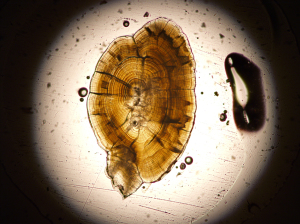
A cross-section of a salmon otolith, also known as a fish ear stone or fish ear bone. (Image Credit: Sean Brennan, University of Washington).
Studying small bones in the ears of Pacific Salmon may be able to tell researchers where the salmon were born and lived during critical developmental years according to new research. Studying them might allow researchers to determine which habitats produce the largest salmon populations, and where the fish live during critical periods of their life.
The result is based on the fact that a chemical element, strontium, accumulates on the otoliths, or ear bones, of fish throughout their lives in a manner similar to how rings form on a tree. The inner otolith rings represent the fish’s early life while outer rings correspond to later years since the type of strontium found in the fish is directly linked to distinct geology of its home waters.
This method could allow researchers to identify key habitats for salmon and thus inform environmental conservation efforts. While the study was made in Alaska British Columbia has a large salmon population whose habitats could be mapped if a baseline map of strontium variation were to be created.
Original research paper published in Science Advances on May 15, 2015.
Names and affiliations of selected authors


